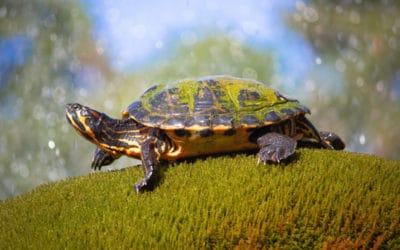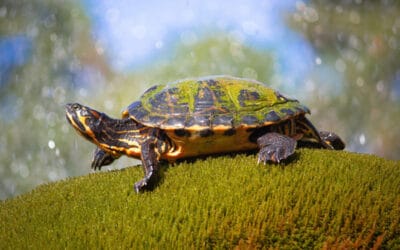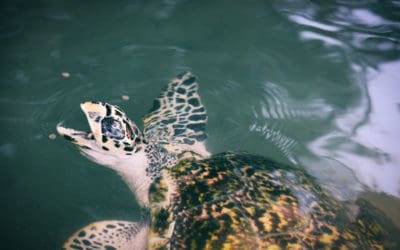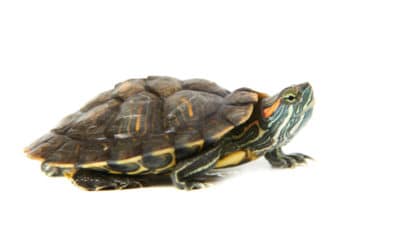Traveling at night is definitely a difficult task for many animals. Obviously, they are nocturnal species, which means they are doing much better with no light around. Nonetheless, most animals, including human beings, love the Sun and the light it gives. The same thing concerns turtles, which are mostly active during daylight. However, does it mean that turtles cannot see in the dark? Well, this is not exactly true.
You see, turtles can see in the dark and they do that in a very similar way to humans. Obviously, they do not have the night vision that allows them to see clearly in the dark. Nonetheless, their eyes are able to adjust to darkness and, thanks to an additional redness gene, they are capable of seeing slightly better than humans.
But how come turtles can see in the dark? What makes it possible and how well they can cope during night time? Well, there are quite a lot of questions and today, with the help of researches as well as a number of scientific projects, I will try to prepare as comprehensive answers to your issues as possible and, therefore, give you all the information thanks to which you will finally realize how turtles’ vision work at night.
How do turtles really see in the dark?
First, let’s start from the basics. You see, being a turtle owner for quite a long time, I figured out that my turtle can actually see me and differentiate my posture from others. Obviously, everything changes when the night comes. However, they are still capable of seeing things mainly due to the fact their eyes are quite similar to ours and after a while, their iris adjusts to the new situation and allows more light into their eyes. Thanks to that, they can see more red shades than people. Therefore, they see more reddish than what humans usually see.
However, in most cases their vision is very similar to ours. Obviously, seeing in the dark requires turtles’ eyes to adjust to the new environment. Just like we do. Simply imagine a situation where it is dark outside, your blinds are closed, and you turn off the last source of light in the room before going to bed. Once you do that, you won’t be able to see anything – even the tip of your own nose. It needs to take some time before we can see some contours and objects that are located closest to us.
The same thing concerns turtles. You see, once the last source of light vanishes, their eyes need to adjust to the new situation. It takes several minutes. However, once it is done, they are able to see in a very similar way to us. Obviously, there are several differences like, for example, the CYP2J19, which is also known as the redness gene.
Gene known as CYP2J19 is definitely really helpful
Almost 250 million years ago there was a particular species of dinosaur known as Archosaur. It had a gene called CYP2J19, which enabled the animal to see more shades of red. This gene was also found in turtles and, as a result, these reptiles are considered to be able to distinguish much more colors of red than human beings. As a result, it is safe to say that turtles can differentiate higher numbers of colors.
It is definitely difficult to understand, since the mixture of three wavelengths (namely red, green, and blue) provides humans with millions of colors. Now imagine that turtles are able to distinguish one more wavelength compared to our three. But how is this redness gene helpful when it comes to seeing in the dark? Well, the fact that there will be a little bit of red in their vision at night makes it a bit clearer.

Is there an option to verify whether turtles have a night vision or not?
Some people may still believe that these reptiles are able to see in the dark. I can even relate to those people to some extent – mainly due to the fact that my own turtle likes to roam around the tank in the middle of the night. At the beginning I thought that they are better prepared for nocturnal life, but that is not the case. They simply use the time they were awake in order for their eyes to adjust to the new reality. As a result, my turtle and probably most of the other pets we have are able to move around the tank even in the dark.
There is; however, a quick way to verify that turtles can’t actually see in the dark in such a good way as, for example, dogs, owls, or some other animals. You see, in order to see in the dark as clearly as during daytime, an animal needs to have something that is called tapetum lucidum. It is a special membrane that has reflective attributes. Since it is positioned behind the eye and acts as a mirror, it allows many animals to catch a lot of light and, therefore, see during nighttime. Obviously, it is all possible thanks to resending photons back to the eye, which is probably the most important task of the tapetum lucidum.
But how can we see whether turtles do have this membrane or not? Well, the easiest way to see it is by taking a photo of our turtle. If you ever pictured a dog in a very bad light, then you probably noticed that its eyes were glowing. And though today’s cameras have much better quality and use a number of different functions to eradicate the problem of glowing eyes and other unnecessary visual effects, it is still possible to see how dogs’ eyes glow in the dark. This is simply because the membrane reflects the light.
If you were to picture your turtle, you are not going to witness the same glow in their eyes. Simply because they do not possess such a membrane – nor do human beings and many other animals that cannot see in the dark.
Tank lights and other sources of light at night
So should we help our turtle and keep some of the lights on at night? Well, we should definitely not do that. You see, turtles need their sleeping schedule sorted out – just like we do. As a result, we have to provide them with the right amount of darkness during a 24-hour cycle just to let them sleep and rest. What is more, if we keep the lights on, we will disrupt their day and night cycle and cause confusion. And this is definitely something we cannot do if we care about the good health condition of our pet.
The only situation where lights turned on seem to be a good idea is if you want to keep an eye on your pet and you are fully aware it is not sleeping. Besides that, the only other reason for lights staying on is because of winter days, where the light is heavily limited and we want to keep approximately the same light time as night time.
How good can turtles see underwater?
Turtles are great at seeing underwater mainly because their vision doesn’t really differ from what they see on land. They are able to witness the exact same colors. Obviously, dirty water will definitely influence the distance they can see and the quality of vision. However, it affects almost every animal in the world. Interestingly, they are able to keep their good vision underwater mainly because of mucus that can be found in their tears. It covers their eyes and, as a result, keeps their eyes free from the salt or bacteria that could be found in the water.
Obviously, the tears that turtles use are of a different kind than what humans do. You see, turtles apply these tears mainly due to hydration reasons. This is not connected to their emotional state or pain. Even if we notice a lot of tears, this usually means that turtles get rid of the excess salt through tears.
Submit your review | |





















